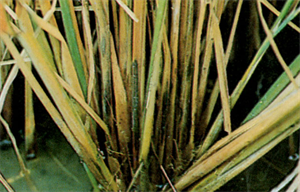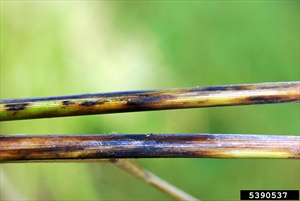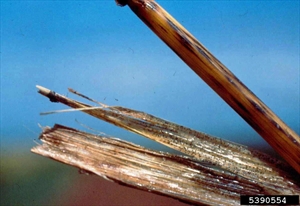Rice stem rot
Pacific Pests, Pathogens and Weeds - Online edition
Pacific Pests, Pathogens & Weeds
Rice stem rot (430)
Magnaporthe salvinii. It is also known under its asexual names, Leptosphaeria salvinii and Sclerotium oryzae. Note, a similar fungus, identified as Sclerotium hydrophilum, associated with infections of the outer leaf sheath of rice and weed grasses occurred on the Guadalcanal Plains, Solomon Islands, in the mid-1970s.
Africa, Asia, North, South and Central America, the Caribbean, Europe, Oceania. It is recorded from Australia, Fiji, New Caledonia, and Papua New Guinea.
Rice is the main host; minor hosts are wild grasses.
The fungus causes stem rot, chalky grains and unfilled panicles. Symptoms appear first on the leaf sheaths near water level during early heading and grain filling (Photo 1).
Hard black balls of fungal threads ('sclerotia') germinate on the leaf sheaths, infect, causing large black spots, which penetrate to the stem; rots on the stem cause lodging and, in severe cases, death of the tillers (Photo 2). Numerous sclerotia form on and inside the leaf sheaths (Photos 3&4). Apart from sclerotia, the fungus produces spores, 'conidia' and sexual 'ascospores'.
Infection is severe on plants damaged by wounds made by insects. Too much nitrogen fertizer and too little potassium affects disease development.
Spread occurs as sclerotia which float in the irrigation water. Sclerotia are also the means of survivial. These are produced on the tillers and survive in the soil, on straw and stubble. They float to the surface during soil preparation and irrigation. Seedborne infection occurs, but its importance is not clear. Infection by sclerotia is thought to be the more likely cause of stem rot.
IRRI reports that it can cause heavy losses in many countries, e.g., India, Japan. the Philippines, and Vietnam. Leaf sheaths decay, resulting in lodging and low grain filling.
Note, similar outbreaks occurred on the Guadalcanal Plains, Solomon Islands, in the mid-1970s, and Sclerotium hydrophilum was shown to be the cause. This was found to be weakly pathogenic, unless plants were weakened by brown planthopper or armyworm attack.
Look for black spreading spots on the leaf sheaths and stems at water level. Look for the many hard black sclerotia on the spots that form on the outside and inside of the leaf sheaths, and within the hollow stems. Look for stem rots that cause lodging.
CULTURAL CONTROL
Before planting:
- Plough the land frequently before sowing or transplanting.
- Applications of lime have been used to reduce soil pH.
During growth:
- Periodically, drain the fields to reduce the number of sclerotia.
- Use the correct balance between nitrogen and potassium fertilizers. It is best to split applications.
After harvest:
- Collect straw and other debris after harvest and burn it with the stubble, or plough everything into the soil.
- Rotate with forage or legume crops.
RESISTANT VARIETIES
There are no highly resistant varieties, although there are differences in ability of varieties to withstand lodging. Contact your local agriculture office for information.
CHEMICAL CONTROL
Copper oxychloride, fentin hydroxide and thiopanate-methyl at the start of the disease is said to be effective, but careful consideration should be given to the economics of this method of control. The possible association of the disease with insect attack by brown plant hopper and armyworm, or with nutritional imbalance should be considered before application of fungicides.
____________________
When using a pesticide, always wear protective clothing and follow the instructions on the product label, such as dosage, timing of application, and pre-harvest interval. Recommendations will vary with the crop and system of cultivation. Expert advice on the most appropriate pesticide to use should always be sought from local agricultural authorities.
AUTHOR Grahame Jackson
Information (and Photo 1) from Stem rot. Rice Knowledge Bank. IRRI. (http://www.knowledgebank.irri.org/training/fact-sheets/pest-management/diseases/item/stem-rot); and CABI (2018) Magnaporthe salvinii (stem rot) Crop Protection Compendium. (https://www.cabi.org/cpc/datasheet/32263); and from Elazegui F, Islam Z (2003) Diagnosis of common diseases of rice. International Rice Research Institute. (http://www.knowledgebank.irri.org/images/docs/diagnostic-of-common-diseases-of-rice.pdf). Photo 2&3 Donald Groth, Louisiana State University AgCenter, Bugwood.org. Photo 4 Milton Rush, Plant Pathology, Louisiana State University, Bugwood.org.
Produced with support from the Australian Centre for International Agricultural Research under project HORT/2016/185: Responding to emerging pest and disease threats to horticulture in the Pacific islands, implemented by the University of Queensland and the Secretariat of the Pacific Community.







